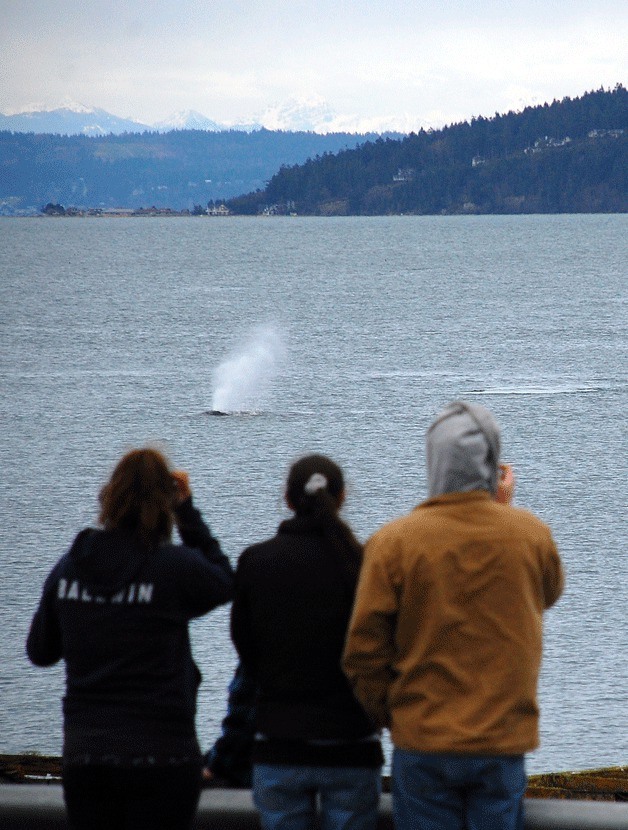A gray whale known as Dubnuk drew a steady crowd of looky-loos and rubber-neckers at the end of Penn Cove Sunday.
For much of the afternoon, the estimated 35-foot-long, 30-ton behemoth was seen trolling back and forth along the shoreline between Grassers Lagoon and the long dock owned by Penn Cove Shellfish. Surfacing every few minutes for air, the rare spectacle lured a seemingly endless stream of a passing motorists.
At one point, the section of Highway 20 was lined with enough observers and parked cars that police officers were called out to direct traffic.
Jill Hein, a board member for the Whidbey Island non-profit whale advocacy group known as Orca Network, said she didn’t arrive until about 3 p.m., several hours after the whale was first noticed. Even then, the area was bustling with onlookers.
“There must have been 100 people out there,” she said.
Hein, a former volunteer whale naturalist for Mystic Sea whale watching tours, identified the gray as number 44, or Dubnuk, of the Saratoga Grays. The group consists of about 10 to 12 individuals that venture into Puget Sound every spring.
While all grays have unique patterns on their backs and the bottom of their flukes, or tails, Dubnuk is relatively easy to identify. The whale has a large chunk of flesh missing from his back just behind his dorsal fin.
He and another gray whale known as Patch have been regulars in the area for over 15 years. According to Hein, they and the other members of the Saratoga Grays are stopping in Puget Sound to eat during their species’ annual migration from the warm-water lagoons of Mexico’s Baja Peninsula to the Chukchi Sea off the northwest coast of Alaska.
“I figure they are stopping in for a snack,” she said.
Grays share the title with humpback’s for having the longest migrations of all whale species. Their annual journey comes in at about 6,000 miles — one way — while humpbacks’ swim to Hawaii is roughly the same distance.
Just which species travels farther is a matter of friendly debate among scientists, according to Orca Network President Howard Garrett. Although no one knows the answer for sure, it is believed that the Saratoga Grays are in fact stopping in Puget Sound to eat.
Garrett said he didn’t have any “good evidence” to support the theory, but that he believes Dubnuk was feeding on ghost shrimp, a type of crustacean that flourishes in mud and sand flats. The area at the end of Penn Cove may host healthy populations of the shrimp, which may be the reason Dubnuk and other grays return to the area year after year.
Garrett said the Saratoga Grays will likely remain in Puget Sound until the end of May, at which time they will continue north to the Bering Sea or remain in the Northwest feeding off the coast of Oregon, Washington, or Vancouver Island.
Not all grays migrate the full distance to Alaska and it’s unknown just how far north the Saratoga Grays actually travel, Garrett said.
If you have pictures of a gray whale and want to identify it, Cascadia Research Collective, an Olympia-based non-profit educational organization, offers a photographic field guide of all known northern Puget Sound grays at www.cascadiaresearch.org/graywhale.htm.
For more information, you can also call the Orca Network at 678-3451.



